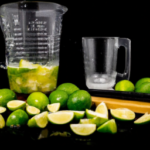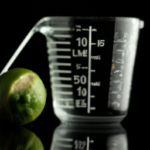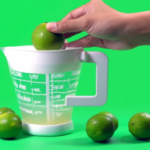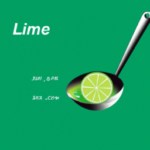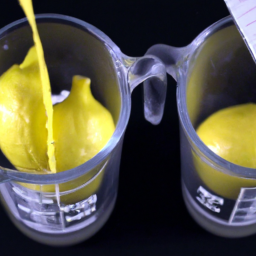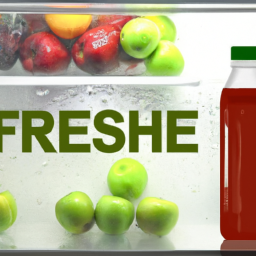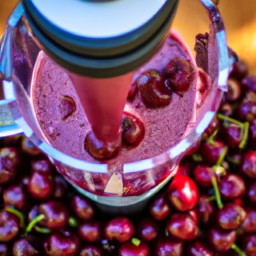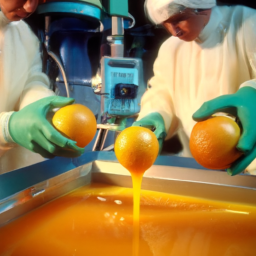As someone who enjoys both cooking and mixology, I am frequently questioned about the amount of limes needed to make 1/3 cup of lime juice. Giving a definitive answer is not easy because it depends on several factors such as the size and juiciness of the limes, as well as the juicing techniques and tools used.
In this article, I will provide a comprehensive guide on how to determine the number of limes needed for 1/3 cup of lime juice. I will discuss factors that affect the amount of juice extracted from limes, such as the type of lime and its ripeness, as well as tips on choosing the best limes for juicing.
Additionally, I will provide step-by-step instructions on how to prepare limes for juicing, different squeezing techniques to maximize juice yield, and tips on measuring and storing lime juice. Whether you’re making a refreshing limeade or a zesty marinade, this article will help you achieve the perfect amount of lime juice every time.
Key Takeaways
- The yield of lime juice can be affected by factors such as size, juiciness, and juicing technique.
- Persian limes may yield more juice than Key limes, and microwaving or rolling limes can increase juice yield.
- Lime juice has health benefits, including aiding digestion and providing vitamin C and antioxidants.
- To store lime juice, refrigerate to maintain freshness for up to 4 weeks or freeze for up to 3-4 months in an airtight container labeled with the date.
Factors Affecting the Amount of Lime Juice
You’ll want to consider various factors that impact the amount of lime juice you can extract, such as the ripeness of the fruit and the juicing method you use.
Lime juice acidity can vary depending on the ripeness of the fruit. Ripe limes are sweeter and less acidic than unripe ones. Therefore, if you want to extract a higher amount of juice, it’s best to choose ripe limes.
Another factor that affects lime juice extraction is the juicing method you use. Hand-squeezing may be the easiest method, but it may not yield the highest amount of juice. To extract the most juice from your limes, consider using a citrus juicer. This tool is designed to extract every last drop of juice from your limes, giving you the most bang for your buck.
Now, let’s talk about how to choose the best limes for juicing.
How to Choose the Best Limes for Juicing
When looking for the best limes to juice, it’s important to choose ones that are firm and heavy for their size, with smooth, glossy skin. Here are some lime selection and juicing tips to ensure you get the most juice and flavor:
- Choose limes that are bright green in color and feel heavy for their size, indicating that they’re juicy.
- Avoid limes that are soft, shriveled, or have brown spots, as they may be overripe or spoiled.
- Look for limes with thinner skin, as they tend to be more juicy than thicker-skinned limes.
- Roll the limes on a hard surface before juicing to help release the juices.
Now that you’ve selected the best limes for juicing, it’s time to gather the tools needed for the task.
Tools Needed for Juicing Limes
To juice your limes, all you need are the right tools. First, choose a sharp knife to cut the limes, avoiding any dull blades that can crush the fruit and prevent the juice from flowing.
Next, find a cutting board and a citrus juicer to help extract the juice easily. There are many juicers available in the market, from manual hand-held press to electric models. Choose the one that suits your needs and budget.
When selecting limes for juicing, you can use any of the varieties available in the market, such as Persian, Key, or Mexican limes. However, keep in mind that the size of the lime affects the amount of juice you can extract. For example, large Persian limes may yield more juice than smaller Key limes.
Regardless of the variety, make sure to pick limes that are firm and heavy, with smooth and shiny skin. With the right juicing equipment and lime selection, you can prepare your limes for juicing and extract the maximum amount of juice.
Preparation of Limes
Get your limes ready to release their zesty goodness by giving them a firm roll on the counter before slicing them open. This helps to break down the membranes inside the lime and makes it easier to extract the juice.
It’s also important to select the right type of lime for juicing. There are several varieties of limes, but the most commonly used for juicing are the Persian and Key limes. When selecting limes, it’s important to consider their seasonality. Limes are typically in season from June to October, but they can be found year-round in most grocery stores.
It’s best to choose limes that are firm and heavy for their size, as they tend to have more juice. Once you have your limes prepared, it’s time to move on to the squeezing techniques.
Without skipping a beat, move on to the subsequent section about squeezing techniques to get the most juice out of your limes.
Squeezing Techniques
Now that you’ve got your perfectly ripe limes, let’s talk about how you can maximize their juice potential with a simple trick: microwaving them for a few seconds before squeezing.
This technique softens the fruit and makes it easier to extract the juice. In fact, a study published in the Journal of Food Science found that microwaving a lime for just 20 seconds can increase its juice yield by up to 27%.
When it comes to squeezing, you have two options: hand or machine squeezing. Hand squeezing is more traditional and allows you to control the pressure and direction of the juice flow. However, it can be tiring and time-consuming if you have a lot of limes to juice.
Machine squeezing, on the other hand, is faster and more efficient, but it can also introduce bitterness to the juice if the machine crushes the bitter membrane of the fruit.
Regardless of which method you choose, it’s important to let the limes come to room temperature beforehand. This helps to loosen the juice and makes it easier to extract.
By now, you know the importance of preparing your limes and the different squeezing techniques available. But how can you maximize the juice yield? Let’s explore some tips and tricks in the next section.
Maximizing Juice Yield
You’ll be blown away by the amount of juice you can extract from your limes if you try this simple trick. Juice extraction can be maximized by microwaving the lime for 10 seconds before squeezing. This helps to break down the cells in the fruit, making it easier to extract the juice.
To further increase juice yield, try rolling the lime on a hard surface with your palm before microwaving it. This will help to loosen the pulp and release more juice. Additionally, different lime varieties can yield varying amounts of juice. For example, key limes have thinner skins and more juice than Persian limes.
When measuring lime juice, remember that 1/3 cup of lime juice requires about 5-6 medium limes. Using this information, you can adjust your recipe accordingly and ensure that you have enough lime juice for your dish.
Measuring Lime Juice
To accurately measure the tartness of your dish, it’s important to know the amount of lime juice required, which can be determined by using 5-6 medium-sized limes. However, getting the most juice out of your limes can be a challenge. Here are some lime juicing tips to help you get the most out of your fruit:
| Lime Juicing Tips | Lime Juice Recipes |
|---|---|
| Roll limes on a hard surface before juicing them | Classic Margarita |
| Microwave limes for a few seconds to soften them | Key Lime Pie |
| Cut limes in half crosswise, not lengthwise | Homemade Salsa |
| Use a citrus juicer or reamer to extract the juice | Ceviche |
These tips will help you get the most juice out of your limes, which is important when you’re trying to measure out 1/3 cup of juice for your recipe. Once you’ve juiced your limes, you can use the juice in a variety of recipes, from classic margaritas to homemade salsa. But lime juice can also be used for other purposes, which we’ll explore in the next section.
Other Uses of Lime Juice
I’ve found that lime juice has a variety of uses beyond simply measuring it out for recipes. It can be used in cooking to add flavor and acidity, as well as in cocktails for a refreshing twist.
Additionally, lime juice has health benefits such as aiding digestion and providing vitamin C.
Cooking
Imagine yourself as a master chef, creating a delicious dish that requires 1/3 cup of lime juice. How many limes will you need for this culinary masterpiece?
The answer depends on a few factors, such as the size and juiciness of the limes, as well as your personal preference for the level of acidity in the dish. Here are some general guidelines to help you estimate the number of limes needed:
-
On average, one lime contains about 2 tablespoons of juice, which means you’ll need around 5-6 limes to yield 1/3 cup.
-
To maximize the juice output, roll the limes on the countertop before cutting them in half and use a citrus reamer or juicer to extract the juice.
-
If you don’t have fresh limes on hand, you can also use bottled lime juice as a substitute. However, be aware that the flavor and acidity may differ from fresh lime juice, so adjust the amount accordingly.
Now that you know how many limes to use for your culinary creation, let’s move on to another use for lime juice: cocktails.
Cocktails
When mixing cocktails, a splash of lime juice can add a refreshing and tangy kick to your drink. But how many limes do you need to get the right amount of juice? The answer depends on the size and juiciness of the limes, as well as your mixing techniques and garnish ideas.
To help you get started, here’s a table that shows how many limes are needed to get 1/3 cup of juice:
| Lime Size | Number of Limes Needed |
|---|---|
| Small | 4-5 |
| Medium | 3-4 |
| Large | 2-3 |
When juicing limes for cocktails, it’s important to use the right technique to get the most juice out of each fruit. One popular method is to roll the lime on a hard surface before cutting it open, to soften the flesh and release the juice. Another tip is to use a hand-held citrus juicer, which can make it easier to extract the juice without getting seeds or pulp in your drink. And when it comes to garnishes, lime wedges or twists can add a pop of color and flavor to your cocktail, while a salted rim can complement the tartness of the lime juice.
Moving on to the health benefits of lime juice, it’s important to note that this citrus fruit is packed with vitamin C and antioxidants, which can help boost your immune system and protect your cells from damage. So not only does lime juice add a zesty flavor to your cocktail, it can also provide some health benefits.
Health Benefits
Get a boost to your immune system and protect your cells from damage with the nutritional benefits of lime juice. Lime juice is a great source of vitamin C, which can help prevent and fight off illnesses such as the common cold. Additionally, the antioxidants found in lime juice can help protect your cells from damage caused by free radicals.
It’s important to note that some people may have a citrus allergy and should avoid consuming lime juice. However, for those who can enjoy it, incorporating lime juice into their diet is a great way to reap its many benefits.
Now, let’s talk about how to properly store lime juice to ensure it stays fresh and flavorful.
Storing Lime Juice
When it comes to storing lime juice, there are a few important factors to consider. First and foremost, refrigeration is essential in order to prevent spoilage and maintain freshness.
Additionally, freezing lime juice is an option for those who want to store it for longer periods of time.
Lastly, using an air-tight container can help to further extend the shelf life of lime juice.
Refrigeration
Keeping your limes in the fridge will help keep them fresh and juicy, making it easier to extract the 1/3 cup of juice you need. Refrigeration slows down the natural ripening process and prevents mold growth, allowing your limes to last longer. This means you can use them for more than just one recipe, saving you money and reducing food waste.
To illustrate the benefits of refrigeration, let’s take a look at the following table:
| Lime Storage Method | Lime Freshness | Lime Juiciness | Lime Shelf Life |
|---|---|---|---|
| Room Temperature | Decreased | Decreased | 1-2 Weeks |
| Refrigeration | Maintained | Maintained | 3-4 Weeks |
| Freezing | Maintained | Slightly Decreased | 3-4 Months |
As you can see, refrigeration is the best way to keep your limes fresh and juicy for up to four weeks. However, if you have leftover limes that you know you won’t use in that time frame, freezing them is a good option to extend their shelf life even further.
Now, let’s explore how freezing limes can be an effective way to store them for later use.
Freezing
Now that we’ve talked about the importance of refrigerating lime juice, let’s move on to the topic of freezing it. Freezing lime juice can be a great way to preserve it for later use, especially if you have an abundance of limes and don’t want them to go to waste.
When freezing lime juice, it’s important to use an airtight container to prevent freezer burn and to label the container with the date so you know how long it’s been in the freezer. There are a variety of uses for frozen lime juice, including using it in cocktails, marinades, and sauces. One of the benefits of using fresh squeezed lime juice is that it has a bright, tangy flavor that can enhance the taste of any dish.
Freezing lime juice allows you to enjoy this fresh flavor even when limes are out of season or not readily available. Overall, freezing lime juice is a convenient way to keep it on hand for whenever you need it.
When it comes to using an airtight container for freezing lime juice, it’s important to make sure that there is as little air in the container as possible. This will help prevent freezer burn and keep the lime juice fresh for longer.
In the next section, we’ll discuss the importance of using an airtight container in more detail.
Using an Air-Tight Container
To ensure your frozen lime juice stays fresh and flavorful, you’ll want to use an airtight container that seals tightly and keeps air out. Here are some benefits of using an airtight container:
-
Prevents freezer burn: When the lime juice is exposed to air, it can cause freezer burn, which can affect the taste and quality of the juice. An airtight container will prevent air from coming in contact with the juice, keeping it fresh and flavorful.
-
Maintains freshness: An airtight container will help maintain the freshness of the lime juice by preventing oxidation. This means that the juice will retain its nutrients and flavor for a longer period of time.
-
Reduces contamination: An airtight container will prevent any external contaminants from entering the lime juice. This is especially important if you plan on storing the juice for an extended period of time.
If you don’t have an airtight container, there are some alternatives that you can use. For example, you can use plastic wrap to cover the container tightly, or you can use a ziplock bag. However, keep in mind that these alternatives may not be as effective as an airtight container and may not provide the same level of protection against freezer burn and contamination. It’s always best to use an airtight container if possible to ensure the best quality and freshness of your frozen lime juice.
Frequently Asked Questions
Can I use bottled lime juice instead of fresh juice for my recipe?
Personally, I’ve found that using fresh lime juice in my recipes yields a tangy, tantalizing taste. However, in terms of convenience, bottled lime juice could be a quick substitute. Pros & Cons: Bottled vs Fresh Lime Juice and Taste Test: Fresh vs Bottled Lime Juice should be considered before making a decision.
How long can I keep lime juice in the fridge before it goes bad?
To maximize the shelf life of lime juice, store it in an airtight container in the refrigerator. It can last up to 2 weeks if properly stored. To prevent spoilage and maintain freshness, avoid exposing it to heat and light. This preserves the flavor for longer.
Should I use a manual or electric juicer for limes?
When it comes to juicing limes, the pros of a manual juicer include ease of use, portability and affordability, while the benefits of an electric juicer include speed and efficiency. Regardless of the type of juicer used, it’s important to clean it thoroughly after each use to avoid contamination and prolong its lifespan.
Can I freeze lime juice for later use?
Freezing lime juice is a convenient way to preserve it for later use. It retains its flavor and nutrients. Benefits include easy access to lime juice for cocktails, marinades, and dressings. Alternative uses include adding it to water for a refreshing drink.
How can I tell if a lime is ripe and ready for juicing?
To choose ripe limes for juicing, I look for ones that are slightly soft and have a thin skin. I roll them on a hard surface to release the juices before cutting. Juicing techniques vary, but I prefer to use a hand-held juicer for maximum yield.
Conclusion
In conclusion, after learning about the factors affecting the amount of lime juice, how to choose the best limes for juicing, the tools needed for juicing limes, preparation of limes, squeezing techniques, maximizing juice yield, measuring lime juice, other uses of lime juice, and storing lime juice, it’s time to put our knowledge to the test.
The suspense is building up, as I’m about to reveal the answer to the question that brought us here – how many limes for 1/3 cup juice?
Drumroll please! The answer is… it depends! It depends on the size and juiciness of the limes, the juicing techniques used, and other factors. However, as a general rule of thumb, you can expect to get around 3-4 tablespoons of juice from one lime, which is approximately 1/6 to 1/8 of a cup.
So, for 1/3 cup juice, you’ll need around 2-3 limes. But remember, always taste as you go and adjust the amount of lime juice accordingly.
Happy juicing!
Ilana has been a vegan for over 10 years. She originally made the switch for health reasons, but soon found herself becoming more and more passionate about the ethical and environmental implications of a vegan lifestyle. Ilana is the author of The Graceful Kitchen, a blog all about veganism. She loves to cook up delicious and nutritious vegan meals, and share her recipes with others who are interested in leading a cruelty-free life. Ilana is also a strong advocate for using whole foods as the foundation of a healthy diet, and believes that going vegan is one of the best ways to achieve this.




